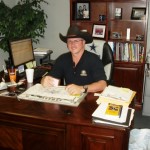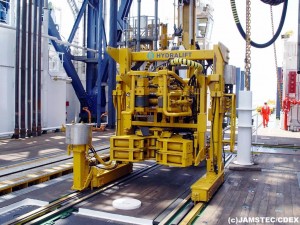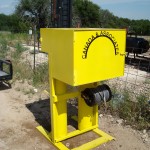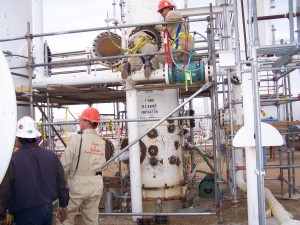The oil and gas industry is similar to the National Football League these days. While the primary focus of each is being productive—whether it is drilling successful wells or scoring touchdowns—much of the emphasis seems to be on safety.
The oil patch is still a dangerous place to work. According to statistics from this region, which includes the Occupational Safety Health Administration (OSHA) offices in El Paso and Lubbock covering everything from Abilene west in Texas, there were 18 fatalities and 352 injuries in oil industry-related accidents in the fiscal year ending last October.
“It is by far safer than it used to be,” McClay emphasized. “Look at the statistics. The incidents-per-worker-hour is less than it was 20 years ago. The oil patch is a lot safer, but we still have a ways to go. When it is man versus machine, the machine always wins. Steel is stronger than humans. Accidents on the road are a major concern, too. Actually it is more dangerous to drive to and from the rig than it is to work on the rig.”
Darrel Canada, president of Canada and Associates Safety Training in Abilene, which
also has offices in Snyder and Midland, said that accidents in the oil patch tend to fall into four categories—struck by, caught between, electrocution, and falls.
Many accidents occur when workers are struck by equipment or caught between tongs, pipe, or trucks backing up. He pointed out that electrocution can occur when the rig is not properly grounded with 8-foot ground rods. Falls happen on pulling units and drilling rigs, as well as in situations when workers are up on trucks, according to Canada.
McClay and Canada are both experts in safety. McClay, a registered chemical and petroleum engineer as well as a certified safety professional, is past president and current treasurer of the Permian Basin chapter of American Society of Safety Engineers. He is also past president of the Texas Society of Professional Engineers. Much of McClay’s work involves testifying in trials as an expert witness after there has been an accident.
Canada, meanwhile, is involved in safety training. He serves on the NORA (National Occupational Research Agenda) council for the Center for Disease Control, which has produced safety videos geared to the oil and gas industry. He also serves on the OSHA
Safety Conference committee, which is working to provide better training for those involved in the oil and gas industry, and is vice president of the Permian Basin STEPS chapter, one of 16 STEPS (the acronym stands for Service, Transmission, Exploration, Production Safety) chapters across the United States.
Canada said the OSHA Safety Conference is scheduled for Dec. 4-5 at the Sheraton Hotel in Dallas. The biennial conference attracted 1,257 safety experts in 2010, and he claimed the goal for this year’s conference is more than 1,400 attendees.
New equipment from full-protection lifelines to H2S monitors and the latest in drug testing will be featured at this year’s OSHA Safety Conference, which is hosted by the University of Texas at Arlington.
H2S certification
Deadly hydrogen sulfide (H2S) gas is still a major concern, according to Canada, who said H2S certification, CPR training, and first aid classes are the most popular classes he teaches.
“It is not just the oil and industry,” he added. “H2S is prevalent in 72 different industries, including landfills, sewer systems, water treatment facilities, tanneries, and fisheries. We make sure people are trained and certified to know where the H2S monitors are located and when to wear available SCBAs [self-contained breathing apparatus].”
Canada said sometimes workers will think there isn’t any H2S at a well site, but a water flood or CO2 flood has changed things and suddenly someone goes down.
“One of the big challenges is all the new people in the industry,” Canada continued. “They don’t realize how big and heavy the equipment is and how bad it hurts if you are struck by it or caught in between.”
“Iron roughnecks”
One of the newest safety advancements, according to McClay, is the “iron roughneck,” which many of the newer rigs have to make up pipe.
“It eliminates the need for throwing chains or Kelly spinners,” he explained. “To make up the joint of pipe, you have to spin it up and tighten it. Previously, you had to use throwing chains or spinners. Now the “iron roughneck” unit does it, which eliminates one of the most dangerous things on a rig. Each joint weighs 400 or more pounds, and collars weigh over 1,000 pounds. That is a lot of weight getting thrown around the rig. The new equipment is [an effort] to eliminate hazards.”
Safety lines
Carelessness is the biggest problem related to falls, McClay offered.
“The API standard (Recommended Practice 54) is a really good standard,” he stated, “if everyone will adhere to it. Most of the falls occur when the worker doesn’t hook up the safety line. The always-on safety line has helped to eliminate falls.”
Chemical safety
McClay agreed with Canada that H2S is a big concern.
“The alkali that is used to control the PH and protect the drill pipe is caustic, and it will eat your skin,” he explained. “You have to protect yourself with personal protection equipment, which includes a rubber apron, rubber gloves, a face shield, and safety glasses.”
He said there are many other hazardous chemicals used in the drilling and fracking processes, including scale inhibitors, corrosion inhibitors, and acid used in stimulating wells.
Public safety
While much of the safety training involves the workers on the rig at the well site, safety emphasis also includes public safety, which has many components, according to McClay.
“We probably don’t protect our well sites as we need to,” he offered. “Well sites and tank batteries in town are fenced, but even in rural areas people still go on private property. There may be a gate, but you can’t keep people out if they want to get in. You just want to keep people from unknowingly entering a hazardous area.”
Signage, warning of the dangers of the well site, is important, too, McClay added.
Safety standards
While many are concerned with the influx of so many new workers in the booming oil and gas industry, McClay said it has been his observation in recent years that accidents seem to be happening with the more experienced hands.
“These people are not adhering to the basic safety standards,” he claimed. “They are doing it the ways they always did it, the way they were taught. The younger workers are getting training and are adhering to the basic safety standards.”
One major change that is benefiting improved safety in the oil patch, according to McClay, is that many of the larger drilling contractors and service companies are putting in their own safety departments, whose primary job is safety.
“Many drilling contractors and service companies have worked hard to instill an outlook of safety in the company,” he said. “They are hiring experienced people and are
doing what it takes to get safety emphasized from top to bottom. That is improving things more than anything else.”
Risk management training
It is obvious that safety in the oil and gas industry is of extreme importance to those in the insurance industry as well. For the sixth straight year, the Risk Management Institute (RMI) at Midland College has received a $100,000 grant from Texas Mutual Insurance Company.
Midland College is one of three community colleges in the state (along with Kilgore College and College of the Mainland in Texas City) that have received the grants from Texas Mutual, according to Rebecca Bell, the dean of community relations and special events at Midland College.
Thanks to the generous donation by Texas Mutual, RMI at Midland College was created to offer seminars on workers’ health and safety for employers, employees, and the general public.
“The grant allows us to train people in risk management and other safety-related programs at no charge,” she said.
The seminars include a wide variety of risk management topics, according to Bell, ranging from general safety topics, such as back safety, ergonomics, fall protection, and OSHA standards, to specific topics such as Introduction to Safety Management, Confined Spaces, Hazmat Training, Drug and Alcohol Awareness for Supervisors, H2S Certification, and CPR/First Air/ and Blood Borne Pathogens. Midland College’s RMI also offers driver safety and forklift safety courses.
The seminars are four to 30 hours in duration. Texas Mutual Insurance Company’s participation allows students to receive, at no cost, CEU’s (continuing education units) for completing the course.
Courses are recommended for business owners/managers, operations managers, safety managers, supervisors, field representatives, field technicians, office personnel, and anyone else interested in learning more about safety.
Bell said more than 2,000 oil and gas industry workers have gone through the courses since the Risk Management Institute was created in 2006.
“I don’t know how to quantify the success of the program,” Bell responded, “but we give surveys at the end of the courses, and they are well-received. The same companies keep sending new employees to take the courses each year, so I know they believe the seminars are beneficial.”
Of course, in the current boom in the Permian Basin, Bell acknowledged that oil companies are hiring new employees every day.
“The key is certification training, not just awareness,” Canada emphasized, “in bringing the level of education up for workers.”
By Al Pickett, special contributor
















